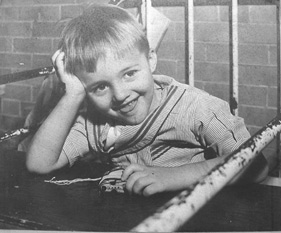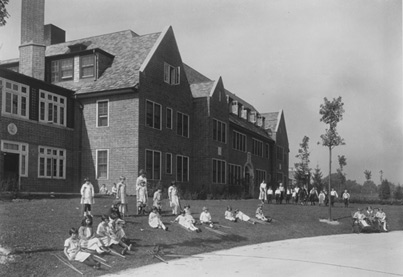The Office of Inspector General would certainly like to know. So would the state survey team or attorney general. But this isn’t that kind of article. This is an article about how staff at a continuing care retirement community (CCRC) encountered what—and who—were in their closet.
The Photographs
In the fall of 2007, volunteers from the Farmington Hills, Mich., local library’s Heritage Collection stopped by Botsford Commons Senior Community to confirm whether a set of photographs they held were from the campus. The familiar markers were there: brick buildings with patios and white-paned tall windows. But also there were child-sized beds with rails and slides—from the second floor to the ground. This campus hadn’t been Farmington Hills’ local playground. Apparently the owners and caretakers had worked to ensure that children found respite and entertainment. They did, and so much more.

In the early 1900s, childhood diseases ran rampant—scarlet fever, tuberculosis, and, more dreaded than most, poliomyelitis—as the country awaited yet-to-come life-saving vaccines. And deformity ran close behind these diseases—limbs, spines, and virtually crippled brain stems. As metro Detroit families wondered how to care for stricken children, local hospitals admitted hundreds into isolation wards. Capacity quickly neared overflowing.
What of the children who were no longer contagious?
Blanche Van Leuven Browne, founder of the Michigan Hospital School for Crippled Children, decided to do something about it. In 1922, she joined forces with James Couzens, mayor of Detroit. Couzens hired renowned architect Albert Kahn to transform Browne’s hospital in Farmington into a residence for children with incapacitating diseases. The two red brick buildings erected on campus, dating to 1922 and 1927, hold architectural markers of their famous originator: slate roofs, American Arts and Crafts-era Pewabic tile surrounding the fireplace, tall windows with low sills, and casts of childhood scenes embedded in the buildings’ exteriors.
An Article Inspires A Reunion
Not long after the library volunteers stopped by, the editor of the local community journal, The Northwest Gazette, called. Could the journal run an article on the historic hospital in Farmington Hills? Yes, it could. The article ran with the facility’s phone number, just in case anyone might call.
The facility’s phone lines rang nonstop in early 2008. Each call introduced Botsford Commons staff to another former patient—one of the children long ago cared for in the site’s famous buildings. And their stories flowed without any encouragement. Removed from home, torn from their families, and allowed no visitors, the now-grown children recalled spending the early days of their contagious period at the mammoth Herman Kiefer Hospital in Detroit.
Once the contagious period passed, if the children survived it, long-term rehab and education became the goal.
Therein lies the beauty of the Farmington Hills site. On a 30-acre campus, it offered the children solace, a dedicated therapy program, and schooling. Visitors were allowed on Sundays only from 1:00 p.m. to 3:00 p.m.
The children’s stories were a local treasure not to be lost. After hours and months of calls, Botsford Commons staff knew, without so much as asking, that the former patients needed to come home. They needed to come back to tell their stories.
The local 100-year flood came on Sept. 13, 2008. Yet through the storm, more than 30 of the site’s many early childhood patients returned to tell their stories. Staff and campus residents volunteered to record narrative histories. The local historical society videotaped the day. The portrait-sized photographs and the time-damaged pictures discovered in the facility’s basements were displayed in the hope that the returning patients would recognize them. One visitor pointed out herself in an Easter costume.
What are the questions to ask the ghosts in the closet when they come back home?
Botsford Commons staff chose simple questions—those they thought a child might be able to recall: “When were you diagnosed? How did you arrive here? What was a typical day like? Which staff do you recall and why? What do you recall of the grounds? Where did you go on outings? What do you recall of the food?” And, last, “What was the most mischievous thing you did during your stay at the hospital?” After all, kids will be kids.
With pens and paper in hand, narrative volunteers recorded the recollections, while the Historical Society captured video snippets. The community room was abuzz, every former patient telling his or her own history and setting it to collective memory.
The Children
The earliest attendee, from the 1920s, recalled picking apples from the neighbor’s farm adjacent to the early hospital’s property.

A patient from the 1950s remembered the boys in his ward maneuvering their beds together in the middle of the room so they could have talcum powder wars. Food they didn’t like went into the toy sacks at the foot of their beds.
One man remembered sneaking out to climb the water tower—even though he had polio. Another recalled lights out at dusk during World War II. A patient from Botsford campus’ skilled nursing center visited briefly to meet one of the infants she had cared for when she was one of the campus’ early nurses.
And later that fall, the campus historian received a hand-written note from a woman who was born on the campus. Her father was the custodian. She visited later that fall to recall the hospital from her family’s perspective. Botsford Commons finally learned where Boy Scout Troop 46 set up camp for the patients: the local Boy Scout troop pitched tents behind the custodian’s home on the property.
The Collection
Historic photographs were donated to the collection at The Walter P. Reuther Library at Wayne State University, in Detroit, where early documents rest in other collections detailing the formative history of the early hospital.
Archivists brought scanners to the reunion, testing a new archival method. Former patients brought mementos and personal photos from their private collections to add to the master collection digitally. These items may be later donated to the collection in original form.
The reunion’s blog site, www.botsfordcommons.org/reunion, has links to the photographic collection.
The campus’ history of healing continues, now providing post-acute and chronic care, dementia care, assisted living, and independent living.
Kimberly Gimmarro, executive assistant/quality specialist, serves as the unofficial campus historian at Botsford Commons Senior Community, a 400-resident retirement community in Farmington Hills, Mich. The community holds the AHCA/NCAL Bronze–Commitment to Quality Awards for its assisted living (2011) and skilled nursing (2012) facilities, and Gimmarro serves as senior examiner in the AHCA/NCAL National Quality Award program. She can be reached at (248) 426-6951 or kgimmarro@botsford.org.